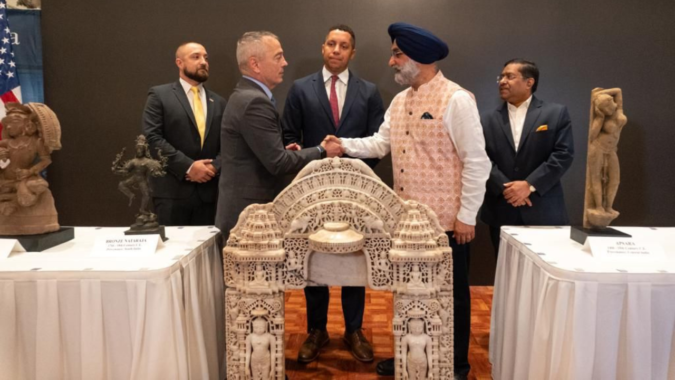NEW DELHI: The US government on Monday formally handed over 105 trafficked antiquities to the Indian authorities in New York.
The handover follows Prime Minister Narendra Modi’s state visit to the US last month, where India and the US agreed to work towards a Cultural Property Agreement that would help prevent illegal trafficking of cultural artefacts. It was decided that such an understanding will add further value to the dynamic bilateral collaboration between US Homeland Security and law enforcement agencies of the two countries.
The antiquities will now be transported to India, where they will remain in the custody of the Archaeological Survey of India until it is decided whether they are to be repatriated to the respective states from where they were originally removed, or put on display at ASI-run museums.
The 105 artefacts represent a wide geographical spread in terms of their origin in India with 47 originally from Eastern India, 27 from South India, 22 from Central India, six from North India and three from Western India.
The historicity of the antiquities spans between the 2nd and 3rd Century CE to 18th-19th century CE and the artefacts include objects made of terracotta, stone, metal and wood.
The handover follows Prime Minister Narendra Modi’s state visit to the US last month, where India and the US agreed to work towards a Cultural Property Agreement that would help prevent illegal trafficking of cultural artefacts. It was decided that such an understanding will add further value to the dynamic bilateral collaboration between US Homeland Security and law enforcement agencies of the two countries.
The antiquities will now be transported to India, where they will remain in the custody of the Archaeological Survey of India until it is decided whether they are to be repatriated to the respective states from where they were originally removed, or put on display at ASI-run museums.
The 105 artefacts represent a wide geographical spread in terms of their origin in India with 47 originally from Eastern India, 27 from South India, 22 from Central India, six from North India and three from Western India.
The historicity of the antiquities spans between the 2nd and 3rd Century CE to 18th-19th century CE and the artefacts include objects made of terracotta, stone, metal and wood.
